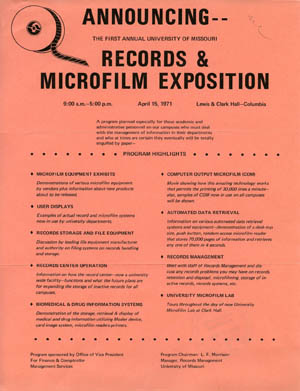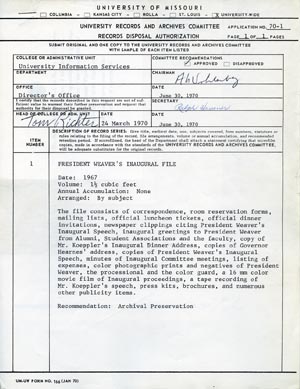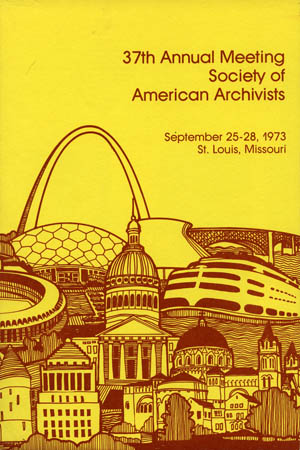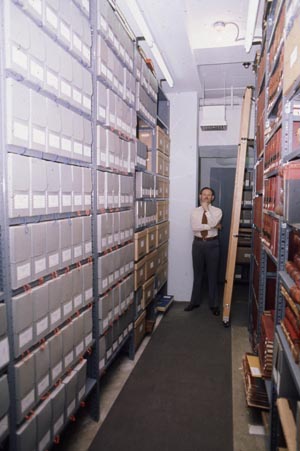Early Records
The University of Missouri existed for 130 years before establishing University Archives in 1969. Many records--a record can very basically be defined as documentation of an individual's or institution's activities--were created during this period, and some of them were retained beyond their immediate use by a variety of often informal means. For example, the University had long stored important documents like the original list of donors for locating the University in Columbia and the meeting minutes and correspondence of the Board of Curators in a safe or vault in Jesse Hall. In 1941 the Board of Curators set a policy to establish a University Archives Collection as a department in the Library to "preserve all printed, photographed and mimeographed matter issued by the University." This collection of printed and duplicated material would become known as the "M" Collection.
To a professor of American history like Elmer Ellis, who knew the value of primary source documents first hand, the need to identify and preserve manuscript collections across Missouri of unpublished personal or family papers or of business records became acute during the years after the United States entered into World War II. Ellis sought funding from the Rockefeller Foundation in 1942 to be used by the University for "its program of research and teaching in American history." Ellis included in his vision for this program the formal organization of the Western Historical Manuscripts Collection (WHMC). Early in 1943 the Rockefeller Foundation promised the University $15,000 over a three-year period, a total to which the University was obligated to commit an additional $5,000, and so WHMC was established and located in the University's Library Building.
 A 1971 flyer announces a day-long program about records management services and technology for campus administrators. The University Microfilm Lab, which was too costly to install in the Records Center facility in the General Services Building, was created in 1970 and was located in Clark Hall where University Archives now stores some of its historical records.
A 1971 flyer announces a day-long program about records management services and technology for campus administrators. The University Microfilm Lab, which was too costly to install in the Records Center facility in the General Services Building, was created in 1970 and was located in Clark Hall where University Archives now stores some of its historical records.
[UW:4/41/11 Box 1]
Records of the Board of Curators show that by the early 1950s, alongside the typical donations and deposits of personal and family papers, records of the University of Missouri were being given to WHMC. In 1949, for instance, the Department of Chemistry deposited some of its papers and those of its former chairman, Herman Schlundt. In 1951, meeting minutes of the University's deans were given to WHMC by the University Library, and the papers of former Professor of History Jonas Viles--the man who brought Ellis to the University of Missouri in 1930, wrote the first published history of the University, and advocated for a University Archivist as early as 1941--were donated by his wife. A University Archives Section was created in WHMC for "collecting records of the operations of the University, business records, department records, etc."
But WHMC wasn't the only answer to what was increasingly becoming a concern to the University's administration: the amount of records the institution was creating and how those records it deemed vital, including burgeoning enrollment records, should be maintained. The most important records of the University were kept in a number of vaults in Jesse Hall. Vault space was limited, however, so the administration turned to a technology that had come of age during the 1930s and 1940s: microfilm. According to an item in the "On Campus" column of the University's January 1948 Missouri Alumnus magazine, "[t]wenty-eight years of University records were filmed on 16 mm. film during the last semester, reducing half the contents of two vaults into one filing cabinet." In this case, nearly two million course cards and registration blanks from the years 1915 to 1938 were captured on microfilm. Microfilm would remain an important part of managing records for the University into the twenty-first century.
In a September 1961 memorandum to campus administrators, University President Elmer Ellis noted that it "has long been university policy that all inactive university manuscript records should be deposited in the Western Historical Manuscripts Collection...," but that "[s]hortage of staff and centralized storage space has prevented this policy from being followed as fully as desirable." Time had come to address in an official manner how to manage the multitude of records produced across the institution. A Board of Curators' recommendation from November of 1962 begins with the statement that "[a]s a result of a continuous study regarding the keeping and maintaining of University business papers and other records, this is a beginning of recommendations to be made in regard to policy on retention of records."
 The first official Records Disposal Authorization (70-1) approved by the University Records and Archives Committee was for records relating to the inauguration of President Weaver in 1967. The recommendation for "Archival Preservation" was granted by the Committee, and the material became the fifth formal accession into the holdings of University Archives as UW:4/2/1.
The first official Records Disposal Authorization (70-1) approved by the University Records and Archives Committee was for records relating to the inauguration of President Weaver in 1967. The recommendation for "Archival Preservation" was granted by the Committee, and the material became the fifth formal accession into the holdings of University Archives as UW:4/2/1.
[UW:4/41/11 Box 1]
While the papers of the Board of Curators would continue to be kept in their original paper format, all other records, the recommendation continued, "after the legal requirements are met, the Federal and State regulations followed, the historical value checked with the Director of the Western Historical Manuscripts..., all papers and records dated prior to June 30, 1952 be destroyed immediately after the appropriate Department Head's approval." Early in 1964 the Board expanded its previous recommendation: the "President shall, through the Comptroller, and with the approval of each appropriate Administrative Head, provide for the retention of University records through the period of their value, or legal requirement, and for their systematic destruction thereafter." All papers and records over 10 years old would now be eligible for disposal, and the University Archives Section of WHMC would review these records and keep those of historical value. Records management had arrived.
Records Management
The need for managing the mass of records created across the University became more and more evident as demands for storage of records increased. The Office of the Comptroller oversaw storage space in the Maintenance Building, just northwest of the Power Plant. Space for a Records Center was set aside in the newly constructed General Services Building east of Memorial Stadium, and the records from the Maintenance Building were moved there starting in late February of 1964. The Records Center offered storage for over 6,000 records boxes and would house MU and Central Administration records in addition to the office of Gerald Hegel, the first Supervisor of Records. Hegel would become Director of Records Management Services in 1967.
Initially an MU unit, the Records Center moved under System administration and Records Management in 1971. The three other University of Missouri campuses at Kansas City, Rolla, and St. Louis had been storing records in facilities on each campus. The Records Center facility in the General Services Building in Columbia was repurposed in 1975 for other records management functions, including all microfilming services, and storage space was leased in the underground facilities of the Space Center in Kansas City, more than doubling storage capacity. The Records Center returned to the Columbia campus in 1983 and moved into a larger space in the Rock Quarry Center. In 1990 the Records Center moved to its current location on LeMone Industrial Boulevard on the eastern edge of the city where all of Records Management's services (records management, records storage, forms management, and microfilming) were consolidated.
 University President Emeritus Elmer Ellis chaired a session entitled "Political Uses of Archives: Patronage, Shrines and Document Worship" at the 37th Annual Meeting of SAA. UMKC Chancellor James Olson was principal speaker at the session advocating "good record keeping as essential to the maintenance of our liberties." University Archivist Ralph Havener served as reporter for the session and chair of a session for SAA's College and University Archives Committee.
University President Emeritus Elmer Ellis chaired a session entitled "Political Uses of Archives: Patronage, Shrines and Document Worship" at the 37th Annual Meeting of SAA. UMKC Chancellor James Olson was principal speaker at the session advocating "good record keeping as essential to the maintenance of our liberties." University Archivist Ralph Havener served as reporter for the session and chair of a session for SAA's College and University Archives Committee.
[UW:4/4/3 Box 3]
The creation of an official records storage facility was complemented by the development of records retention processes in the early 1960s. The Office of the Comptroller and its Records Retention Study Committee were instrumental in formulating the 1962 and 1964 Board of Curators' recommendations that outlined the basic decision-making process for retaining or destroying University records. The Committee made decisions on how to manage personnel records, payroll records, vouchers and warrants, purchasing records, etc. as well as what official forms to use in Records Management Services. Even decisions on selling records for salvage came under the Committee's purview. Decisions on the historical value of records, however, were always reserved for the University Archives Section of WHMC. As an early Records Center Procedure Manual put it, "[i]t should be strongly pointed out that no one, including the Center is to destroy any records without consulting the University Archival [sic] Section. Only after their expressed opinion as to lack of historical value may any records be destroyed." Decisions on the historical nature of records were made for the Section by the Committee on University Archives which in 1962 included among its members Director of WHMC Lewis Atherton, Director of the State Historical Society of Missouri Richard Brownlee, Dean of Extra-Divisional Administration Thomas Brady, University Business Manager Dale Bowling, and University Librarian Ralph Parker.
University Archives
One component of a complete records keeping system was still missing, however: an official archives for University records headed by a professional archivist. According to University President John Weaver, bringing a professional archivist to the University had been a priority since he was hired to lead the University in 1966. Weaver charged a committee of Elmer Ellis, Lewis Atherton, Richard Brownlee, and Gerald Hegel to recommend procedures for creating a University-wide archival program. In March 1968 the Committee recommended to Weaver that the archivist "have an M.A. degree, or the equivalent, in history, (or library science with training in archival duties)" and defined the position's purview as having "the authority and responsibility to develop uniform and continuing archival programs on each campus of the University and to supervise a central archives."
The Committee's recommendation met with official approval and the members were asked to constitute a search committee for the position, a search that led to the appointment of Ralph S. Havener, Jr., as University Archivist in August of 1969. After receiving degrees from the University of Miami and the University of Wisconsin, Havener had been employed as an archivist first for the University of Wisconsin in the late 1950s, then for the State of Illinois, and finally as College Archivist for Black Hawk College in Moline, Illinois--the last position being in addition to an assistant professorship in the College's Department of Social Sciences. At the University of Missouri Havener reported to the System Office of Vice President for Administration and was given an office on the 7th floor of Lewis Hall, the former dormitory that had only recently been converted to office space.
In late 1969 the University Records and Archives Committee was formed around Havener to formulate policies for the new University Archives program. President Weaver presented the completed policies to the Board of Curators and they were approved in February of 1970. The three main stipulations were that the University Archivist "obtain for preservation the professional and personal manuscripts of academic and administrative staff and the records of student and faculty organizations"; that the "Chancellor of each campus shall appoint a person to work with the University Archivist in developing an archival program for his campus and to assist in the coordination and maintaining of the central University Archives"; and that the University Records and Archives Committee shall "determine what University records have administrative, legal, fiscal or historical value and should not be destroyed or otherwise disposed of and shall authorize destruction or disposal of other records." The last of these policies essentially shifted the responsibility and authority of the earlier Committee on University Archives to the University Records and Archives Committee.
Armed with this mandate, Havener slowly built the archival collections, initially finding storage space on the 7th floor of Lewis Hall and expanding into the basement of Clark Hall during 1970. By the end of 1971, Havener and his staff had brought in nearly 600 cubic feet of records, mostly of official University records transferred through the University Records and Archives Committee. Other records came through "personal contacts with faculty, staff and students." Additional storage space, however, was more difficult to come by than additional records. Over the next ten years new offices were added and remodeled on the 7th floor of Lewis Hall, the old microfilm room of Records Management in Clark Hall was repurposed for storage, and storage lockers were purchased and installed in basement halls of both buildings. Eventually, however, the Records Center would prove the most expansive storage option for the majority of the Archives' records. By the late 1980s, University Archives' collections of MU and University of Missouri System records had increased to over 5,000 cubic feet.
 University Archivist Ralph Havener surveys rows of shelving in the basement of Clark Hall in 1975. The space was one of the first storage locations assigned to University Archives and it remains in use today. During the first decade of the twenty-first century, the space was ceded for a number of years to the digitization unit of the University of Missouri Library Systems Office.
University Archivist Ralph Havener surveys rows of shelving in the basement of Clark Hall in 1975. The space was one of the first storage locations assigned to University Archives and it remains in use today. During the first decade of the twenty-first century, the space was ceded for a number of years to the digitization unit of the University of Missouri Library Systems Office.
[UW:4/161/3]
As director, Havener was responsible for archival efforts on all four campuses of the University. The Kansas City and St. Louis campuses each had an Associate Archivist whose primary role, however, was oversight of the WHMC collections on that campus. At Rolla a faculty member from the history department held a quarter-time appointment as Associate Archivist for administration of the archival collections. In 1988 a five-year review process in line with the University's Long Range Plan was undertaken in the Office of the Vice President for Academic Affairs. As part of this process, an external review committee was hired to evaluate University Archives, Records Management, and the Western Historical Manuscript Collection at the University of Missouri, and the committee issued its report in January of 1989. Recommendations from the review committee for the Columbia campus included moving University Archives to Ellis Library and placing the archives and WHMC "under a single leadership below the Vice Presidential level, with each administered by a single subordinate of that leadership."
Havener retired in October of 1990, and, in accordance with a December 1991 decision by the Board of Curators, responsibility for the archives program was localized on each campus and the University System and Columbia campus collections were placed under the administration of the MU Libraries. In 1999 staff positions in the archives were reclassified to align with positions in the Libraries.
After a number of years under interim leadership, a search for the next permanent director for University Archives was conducted in 1996. Michael Holland was hired in 1997 as the second full-time Director of University Archives. After receiving degrees at Oklahoma State University and Johns Hopkins University, and completing a fellowship at Yale University, Holland directed local records and preservation programs for the states of Oklahoma, Texas, and Tennessee. Holland also served as University Archivist and Director of Records Management at Appalachian State University and at Oregon State University, before arriving at the University of Missouri.
One of Holland's top priorities was the creation of the University Archives' website. He used this platform to make information about the records held in the Archives available to the general public in the form of HTML-encoded descriptions for each collection. He also began teaching a sequence of graduate-level courses on archives for the University's Department of History and the School of Information Science and Learning Technologies.
Under Holland, University Archives joined with Special Collections in the MU Libraries to create the Special Collections, Archives, and Rare Books Division. Holland formed a close association with the University's Library Systems Office (LSO), collaborating on numerous grant and digitization projects that resulted in web access to the University's yearbooks, alumni magazines, department histories, and Extension publications. LSO would become instrumental in providing suitable storage for the increasing number of electronic records added to University Archives during the first decade of the twenty-first century. Holland retired from the University in early 2017.
Today the holdings of University Archives number well over 10,000 cubic feet of records and more than 10 terabytes of electronic records. Material in the Archives' care ranges from photographs to posters, 16mm film to video tape, walking sticks to banners, and blueprints to webpages. Research interest in the University's records and its past comes from all over the world, and, as University Archives begins its next 50 years, it is well situated to continue to serve the University of Missouri as its institutional memory.
Comments? Questions? Contact University Archives
[University Archives commemorated its 50th anniversary with a four-part exhibit in Ellis Library at the University of Missouri. The exhibit ran from August 20th through December 14th, 2019. This web exhibit is based on the second of the four parts. An image of the original display can be seen here.]
